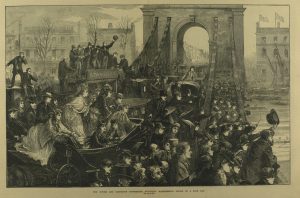Civic Celebration
When, in Sala’s words, there was ‘no war afoot’ the Specials were routinely deployed to report on domestic events. Their standard assignments ranged from reporting on annual occasions in the British calendar, such as the Oxford and Cambridge boat race, to the yearly ‘Autumn Manoeuvres’ of the army on Salisbury plain.

‘The Oxford and Cambridge Universities Boat Race: Hammersmith Bridge on a Race Day’, Illustrated London News, 23 March 1872, p. 295.
Newspaper Image © The British Library Board. All rights reserved. With thanks to The British Newspaper Archive (www.BritishNewspaperArchive.co.uk).
Usually seen from the perspective of the teeming crowds watching the boat race from Hammersmith Bridge, as in this example that appeared in the Illustrated London News on 23 March 1872, the illustrations (both verbal and visual) sought to replicate accurately the experience of seeing the race first-hand. Just starting on his career for the Graphic, Sydney Prior Hall often provided additional ‘Artist’s Notes’ that revealed the physical conditions under which his sketches had been produced. These were published alongside the final engraving, with word and image working together to animate the description in the reader’s imagination. Of the race in March 1873, he described the ‘detestable weather’ during two preliminary trips to Putney ‘to see the crews’, the whistling, cold, north-east wind and how he drew ‘till my hand was too numbed to draw’ (‘The University Boat Race’, Graphic, 29 March 1873, p. 287’). Then, on the day of the race itself, he recorded:
It was a thick pea-soup fog at the Temple Pier when I embarked on board the Press boat. What is the good of an artist in a fog? A fellow’s occupation’s gone. I could see nothing distinctly but the round red disc of the sun, for all the world like an illuminated gelatin lozenge set in decayed Cheddar cheese. So I caricatured the sun, and then tried to catch the forms of phantom vessels flitting by to see the Race.
Notably he reveals the presence of a photographer on the barge, whose ‘hand’ similarly ‘trembles at his lens’, but at this stage, the limitations of the technology (the long exposure time needed and the inability to reproduce the photographic image in the pages of the press) meant that the Special Artist was best placed to document the spontaneity of ‘Le moment psychologique!’. Hall did so by capturing the charged atmosphere in his image and by supplying an evocative description of how it felt to be there:
They’re off. So is the umpire’s boat, so are we, but slowly, and we can’t keep up, worse luck to it! I sketch the Umpire’s boat ahead of us, and the two Eights at her bows, with a bit of Hammersmith Bridge in the distance. Everything is in the distance now, for us, at least, for we are locked in the embraces of the Oxford steamer, and the crowd on the bank are jeering at us.
(‘An Artist’s Notes at the Oxford and Cambridge Boat Race, Graphic, 5 April 1873, p. 311.)